+ Open data
Open data
- Basic information
Basic information
| Entry |  | |||||||||
|---|---|---|---|---|---|---|---|---|---|---|
| Title | CPV Total-Fab Polyclonal A Site Fab | |||||||||
 Map data Map data | ||||||||||
 Sample Sample |
| |||||||||
 Keywords Keywords | CPV / polyclonal Fab /  A site / A site /  vaccination / vaccination /  VIRUS / VIRUS-IMMUNE SYSTEM complex VIRUS / VIRUS-IMMUNE SYSTEM complex | |||||||||
| Function / homology |  Function and homology information Function and homology informationpermeabilization of host organelle membrane involved in viral entry into host cell / symbiont entry into host cell via permeabilization of inner membrane / microtubule-dependent intracellular transport of viral material towards nucleus / adhesion receptor-mediated virion attachment to host cell / T=1 icosahedral viral capsid / viral penetration into host nucleus / clathrin-dependent endocytosis of virus by host cell / entry receptor-mediated virion attachment to host cell / host cell nucleus / structural molecule activity /  metal ion binding metal ion bindingSimilarity search - Function | |||||||||
| Biological species |   Canis lupus familiaris (dog) Canis lupus familiaris (dog) | |||||||||
| Method |  single particle reconstruction / single particle reconstruction /  cryo EM / Resolution: 3.6 Å cryo EM / Resolution: 3.6 Å | |||||||||
 Authors Authors | Hartmann SR / Hafenstein SL / Charnesky AJ | |||||||||
| Funding support |  United States, 2 items United States, 2 items
| |||||||||
 Citation Citation |  Journal: Commun Biol / Year: 2023 Journal: Commun Biol / Year: 2023Title: Cryo EM structures map a post vaccination polyclonal antibody response to canine parvovirus. Authors: Samantha R Hartmann / Andrew J Charnesky / Simon P Früh / Robert A López-Astacio / Wendy S Weichert / Nadia DiNunno / Sung Hung Cho / Carol M Bator / Colin R Parrish / Susan L Hafenstein /  Abstract: Canine parvovirus (CPV) is an important pathogen that emerged by cross-species transmission to cause severe disease in dogs. To understand the host immune response to vaccination, sera from dogs ...Canine parvovirus (CPV) is an important pathogen that emerged by cross-species transmission to cause severe disease in dogs. To understand the host immune response to vaccination, sera from dogs immunized with parvovirus are obtained, the polyclonal antibodies are purified and used to solve the high resolution cryo EM structures of the polyclonal Fab-virus complexes. We use a custom software, Icosahedral Subparticle Extraction and Correlated Classification (ISECC) to perform subparticle analysis and reconstruct polyclonal Fab-virus complexes from two different dogs eight and twelve weeks post vaccination. In the resulting polyclonal Fab-virus complexes there are a total of five distinct Fabs identified. In both cases, any of the five antibodies identified would interfere with receptor binding. This polyclonal mapping approach identifies a specific, limited immune response to the live vaccine virus and allows us to investigate the binding of multiple different antibodies or ligands to virus capsids. | |||||||||
| History |
|
- Structure visualization
Structure visualization
| Supplemental images |
|---|
- Downloads & links
Downloads & links
-EMDB archive
| Map data |  emd_26788.map.gz emd_26788.map.gz | 27.1 MB |  EMDB map data format EMDB map data format | |
|---|---|---|---|---|
| Header (meta data) |  emd-26788-v30.xml emd-26788-v30.xml emd-26788.xml emd-26788.xml | 20.3 KB 20.3 KB | Display Display |  EMDB header EMDB header |
| FSC (resolution estimation) |  emd_26788_fsc.xml emd_26788_fsc.xml | 9.1 KB | Display |  FSC data file FSC data file |
| Images |  emd_26788.png emd_26788.png | 208.3 KB | ||
| Filedesc metadata |  emd-26788.cif.gz emd-26788.cif.gz | 5.7 KB | ||
| Others |  emd_26788_additional_1.map.gz emd_26788_additional_1.map.gz emd_26788_additional_2.map.gz emd_26788_additional_2.map.gz emd_26788_half_map_1.map.gz emd_26788_half_map_1.map.gz emd_26788_half_map_2.map.gz emd_26788_half_map_2.map.gz | 777.2 MB 398.3 MB 23 MB 23 MB | ||
| Archive directory |  http://ftp.pdbj.org/pub/emdb/structures/EMD-26788 http://ftp.pdbj.org/pub/emdb/structures/EMD-26788 ftp://ftp.pdbj.org/pub/emdb/structures/EMD-26788 ftp://ftp.pdbj.org/pub/emdb/structures/EMD-26788 | HTTPS FTP |
-Related structure data
| Related structure data | 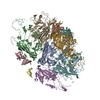 7utsMC 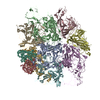 7utpC 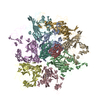 7utrC 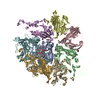 7utuC 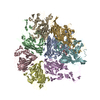 7utvC M: atomic model generated by this map C: citing same article ( |
|---|---|
| Similar structure data | Similarity search - Function & homology  F&H Search F&H Search |
- Links
Links
| EMDB pages |  EMDB (EBI/PDBe) / EMDB (EBI/PDBe) /  EMDataResource EMDataResource |
|---|---|
| Related items in Molecule of the Month |
- Map
Map
| File |  Download / File: emd_26788.map.gz / Format: CCP4 / Size: 30.5 MB / Type: IMAGE STORED AS FLOATING POINT NUMBER (4 BYTES) Download / File: emd_26788.map.gz / Format: CCP4 / Size: 30.5 MB / Type: IMAGE STORED AS FLOATING POINT NUMBER (4 BYTES) | ||||||||||||||||||||
|---|---|---|---|---|---|---|---|---|---|---|---|---|---|---|---|---|---|---|---|---|---|
| Voxel size | X=Y=Z: 1.1 Å | ||||||||||||||||||||
| Density |
| ||||||||||||||||||||
| Symmetry | Space group: 1 | ||||||||||||||||||||
| Details | EMDB XML:
|
-Supplemental data
-Additional map: #2
| File | emd_26788_additional_1.map | ||||||||||||
|---|---|---|---|---|---|---|---|---|---|---|---|---|---|
| Projections & Slices |
| ||||||||||||
| Density Histograms |
-Additional map: #1
| File | emd_26788_additional_2.map | ||||||||||||
|---|---|---|---|---|---|---|---|---|---|---|---|---|---|
| Projections & Slices |
| ||||||||||||
| Density Histograms |
-Half map: #2
| File | emd_26788_half_map_1.map | ||||||||||||
|---|---|---|---|---|---|---|---|---|---|---|---|---|---|
| Projections & Slices |
| ||||||||||||
| Density Histograms |
-Half map: #1
| File | emd_26788_half_map_2.map | ||||||||||||
|---|---|---|---|---|---|---|---|---|---|---|---|---|---|
| Projections & Slices |
| ||||||||||||
| Density Histograms |
- Sample components
Sample components
-Entire : Canine parvovirus in complex with antibody fragment
| Entire | Name: Canine parvovirus in complex with antibody fragment |
|---|---|
| Components |
|
-Supramolecule #1: Canine parvovirus in complex with antibody fragment
| Supramolecule | Name: Canine parvovirus in complex with antibody fragment / type: complex / ID: 1 / Parent: 0 / Macromolecule list: all |
|---|
-Macromolecule #1: Capsid protein VP1
| Macromolecule | Name: Capsid protein VP1 / type: protein_or_peptide / ID: 1 / Number of copies: 8 / Enantiomer: LEVO |
|---|---|
| Source (natural) | Organism:   Canis lupus familiaris (dog) Canis lupus familiaris (dog) |
| Molecular weight | Theoretical: 61.562367 KDa |
| Recombinant expression | Organism:   Felis catus (domestic cat) Felis catus (domestic cat) |
| Sequence | String: GVGISTGTFN NQTEFKFLEN GWVEITANSS RLVHLNMPES ENYRRVVVNN MDKTAVNGNM ALDDIHAQIV TPWSLVDANA WGVWFNPGD WQLIVNTMSE LHLVSFEQEI FNVVLKTVSE SATQPPTKVY NNDLTASLMV ALDSNNTMPF TPAAMRSETL G FYPWKPTI ...String: GVGISTGTFN NQTEFKFLEN GWVEITANSS RLVHLNMPES ENYRRVVVNN MDKTAVNGNM ALDDIHAQIV TPWSLVDANA WGVWFNPGD WQLIVNTMSE LHLVSFEQEI FNVVLKTVSE SATQPPTKVY NNDLTASLMV ALDSNNTMPF TPAAMRSETL G FYPWKPTI PTPWRYYFQW DRTLIPSHTG TSGTPTNIYH GTDPDDVQFY TIENSVPVHL LRTGDEFATG TFFFDCKPCR LT HTWQTNR ALGLPPFLNS LPQSEGATNF GDIGVQQDKR RGVTQMGNTN YITEATIMRP AEVGYSAPYY SFEASTQGPF KTP IAAGRG GAQTDENQAA DGNPRYAFGR QHGQKTTTTG ETPERFTYIA HQDTGRYPEG DWIQNINFNL PVTNDNVLLP TDPI GGKTG INYTNIFNTY GPLTALNNVP PVYPNGQIWD KEFDTDLKPR LHVNAPFVCQ NNCPGQLFVK VAPNLTNEYD PDASA NMSR IVTYSDFWWK GKLVFKAKLR ASHTWNPIQQ MSINVDNQFN YVPSNIGGMK IVYEKSQLAP RKLY UniProtKB:  Capsid protein VP1 Capsid protein VP1 |
-Macromolecule #2: Light chain antibody fragment
| Macromolecule | Name: Light chain antibody fragment / type: protein_or_peptide / ID: 2 / Number of copies: 1 / Enantiomer: LEVO |
|---|---|
| Source (natural) | Organism:   Canis lupus familiaris (dog) Canis lupus familiaris (dog) |
| Molecular weight | Theoretical: 7.93277 KDa |
| Sequence | String: (UNK)(UNK)(UNK)(UNK)(UNK)(UNK)(UNK)(UNK)(UNK)(UNK) (UNK)(UNK)(UNK)(UNK)(UNK)(UNK) (UNK)(UNK)(UNK) (UNK)(UNK)(UNK)(UNK)(UNK)(UNK)(UNK)(UNK)(UNK)(UNK) (UNK)(UNK)(UNK) (UNK)(UNK)(UNK)(UNK)(UNK) ...String: (UNK)(UNK)(UNK)(UNK)(UNK)(UNK)(UNK)(UNK)(UNK)(UNK) (UNK)(UNK)(UNK)(UNK)(UNK)(UNK) (UNK)(UNK)(UNK) (UNK)(UNK)(UNK)(UNK)(UNK)(UNK)(UNK)(UNK)(UNK)(UNK) (UNK)(UNK)(UNK) (UNK)(UNK)(UNK)(UNK)(UNK)(UNK) (UNK)(UNK)(UNK)(UNK)(UNK)(UNK)(UNK)(UNK)(UNK)(UNK) (UNK)(UNK)(UNK)(UNK)(UNK)(UNK)(UNK)(UNK)(UNK) (UNK)(UNK)(UNK)(UNK)(UNK)(UNK)(UNK) (UNK)(UNK) (UNK)(UNK)(UNK)(UNK)(UNK)(UNK)(UNK)(UNK)(UNK)(UNK) (UNK)(UNK)(UNK)(UNK) (UNK)(UNK)(UNK)(UNK)(UNK) (UNK)(UNK)(UNK)(UNK)(UNK)(UNK)(UNK)(UNK) |
-Macromolecule #3: Heavy chain antibody fragment
| Macromolecule | Name: Heavy chain antibody fragment / type: protein_or_peptide / ID: 3 / Number of copies: 1 / Enantiomer: LEVO |
|---|---|
| Source (natural) | Organism:   Canis lupus familiaris (dog) Canis lupus familiaris (dog) |
| Molecular weight | Theoretical: 9.379553 KDa |
| Sequence | String: (UNK)(UNK)(UNK)(UNK)(UNK)(UNK)(UNK)(UNK)(UNK)(UNK) (UNK)(UNK)(UNK)(UNK)(UNK)(UNK) (UNK)(UNK)(UNK) (UNK)(UNK)(UNK)(UNK)(UNK)(UNK)(UNK)(UNK)(UNK)(UNK) (UNK)(UNK)(UNK) (UNK)(UNK)(UNK)(UNK)(UNK) ...String: (UNK)(UNK)(UNK)(UNK)(UNK)(UNK)(UNK)(UNK)(UNK)(UNK) (UNK)(UNK)(UNK)(UNK)(UNK)(UNK) (UNK)(UNK)(UNK) (UNK)(UNK)(UNK)(UNK)(UNK)(UNK)(UNK)(UNK)(UNK)(UNK) (UNK)(UNK)(UNK) (UNK)(UNK)(UNK)(UNK)(UNK)(UNK) (UNK)(UNK)(UNK)(UNK)(UNK)(UNK)(UNK)(UNK)(UNK)(UNK) (UNK)(UNK)(UNK)(UNK)(UNK)(UNK)(UNK)(UNK)(UNK) (UNK)(UNK)(UNK)(UNK)(UNK)(UNK)(UNK) (UNK)(UNK) (UNK)(UNK)(UNK)(UNK)(UNK)(UNK)(UNK)(UNK)(UNK)(UNK) (UNK)(UNK)(UNK)(UNK) (UNK)(UNK)(UNK)(UNK)(UNK) (UNK)(UNK)(UNK)(UNK)(UNK)(UNK)(UNK)(UNK)(UNK)(UNK) (UNK) (UNK)(UNK)(UNK)(UNK)(UNK)(UNK)(UNK)(UNK) (UNK)(UNK)(UNK)(UNK)(UNK)(UNK) |
-Experimental details
-Structure determination
| Method |  cryo EM cryo EM |
|---|---|
 Processing Processing |  single particle reconstruction single particle reconstruction |
| Aggregation state | particle |
- Sample preparation
Sample preparation
| Buffer | pH: 7.4 |
|---|---|
| Vitrification | Cryogen name: ETHANE |
- Electron microscopy
Electron microscopy
| Microscope | FEI TITAN KRIOS |
|---|---|
| Electron beam | Acceleration voltage: 300 kV / Electron source:  FIELD EMISSION GUN FIELD EMISSION GUN |
| Electron optics | Illumination mode: FLOOD BEAM / Imaging mode: BRIGHT FIELD Bright-field microscopy / Nominal defocus max: 2.5 µm / Nominal defocus min: 0.5 µm Bright-field microscopy / Nominal defocus max: 2.5 µm / Nominal defocus min: 0.5 µm |
| Image recording | Film or detector model: FEI FALCON III (4k x 4k) / Average electron dose: 45.0 e/Å2 |
| Experimental equipment |  Model: Titan Krios / Image courtesy: FEI Company |
 Movie
Movie Controller
Controller



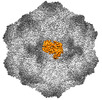





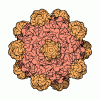

 Z
Z Y
Y X
X


































